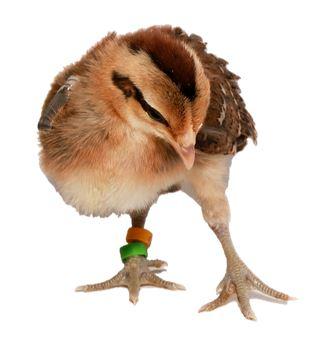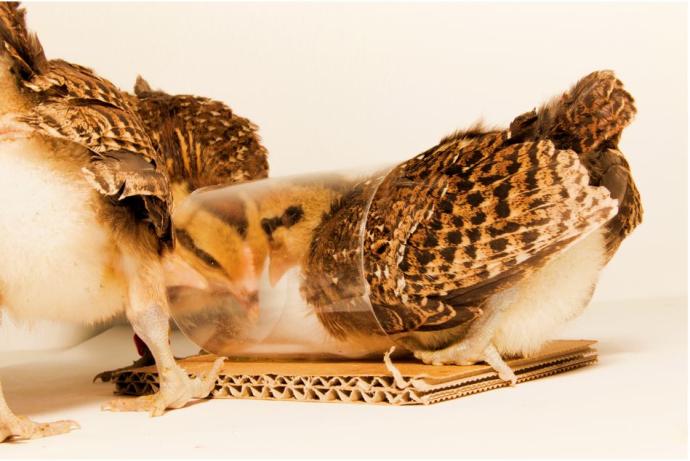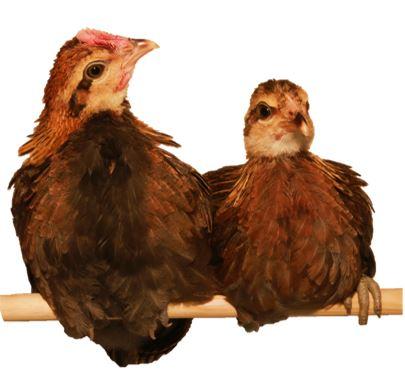Discussion
Summary of findings

By experimentally manipulating group sizes, my study confirms a causal link between group size and individual cognitive performance. Based on the Social Intelligence Hypothesis, I predicted that individuals in larger groups would perform better than those in small groups in cognitive tests of inhibitory control, discriminative- and reversal learning. This relationship, however, turned out to be inconsistent with my findings. The effect of group size on cognitive performance was dependent on the cognitive trait in question, and was observed to be both positive and negative. Chicks raised in large groups had better inhibitory control than those in small groups, but performed worse in discriminative learning than chicks in small groups. Group size had no effect on performance in reversal learning, nor in inhibitory control and discriminative learning when tested again in early adulthood. As chicks in small groups interacted, on overage, more than chicks in large groups, I found no clear support for large groups being more socially complex than small groups. Further, the occurrence of other behaviours (i.e. resting, foraging, vigilance) did not differ between group sizes.
"This study weakly supports the Social Intelligence Hypothesis and provides evidence for a causal role of group size on cognitive performance"
a
Did group size affect cognitive performance in red junglefowl chicks?

In my study, the modular effect of group size on cognition could be explained by different underlying mechanisms for each cognitive trait, e.g. underlying neuroendocrinological or genetic pathways. Therefore, my results support the view that cognition in red junglefowl is domain-specific.
An important difference between the other four cognitive studies with ecologically relevant group sizes and my work is that I was able to causally test the effect of social grouping on cognition. Although the four previous studies attempted to rule out potential contributors to cognition (other than group size), none could explicitly show a causal relationship between group size and cognition. Therefore, my study is the first to unequivocally show a causal link between group size and cognitive performance, by using chicks with known family history (and controlled for it) and raised in experimental group sizes from their first day of life. Future research should aim to confirm this and define whether group size modulates variation in cognitive performance through social factors, or through other mechanisms.
a
How did group size affect cognitive performance?
The social effects of group size on cognition, proposed by the Social Intelligence Hypothesis, are not strongly supported by my results. Firstly, individuals in large groups did not outperform those in small groups in all cognitive tests. Secondly, while the total number of interactions was higher in large groups, individuals interacted more, on average, in small groups. This suggests that large groups were not necessarily more complex. In some situations, increasing group size may not increase the complexity of the social environment, but may even decrease it. For example, in a study in young Japanese quails, Coturnix japonica, social bonding decreased with increasing group size.

Furthermore, I found no support for my predictions that cognitive performance would be affected by differences in disturbances, vigilance or food competition between group sizes. In line with the lack of differences between groups in rest disturbances, resting frequencies during testing did not differ between group sizes either. Foraging disturbances and frequencies were similar across groups, which indicates that food competition did not differ between group sizes. Additionally, all chicks, regardless of group size, were similarly motivated by food, even when they had to work for it. Body condition and body fat did not differ between group sizes either. Altogether, this suggests that differences in cognitive performance between group sizes are likely due to other aspects not considered here. Thus, the mechanisms behind these differences need further exploration.

I suggest that group size differences in cognitive performance could have been affected by how much space chicks had to move within their pens. Chicks in large groups were more likely to collide with others when they moved around than chicks in small groups. As inhibitory control is needed to avoid collisions, chicks in large groups would have had more opportunities to practice their inhibitory control responses and, consequently, showed better inhibitory control than chicks in small groups. On the other hand, because of the greater amount of space, chicks from small groups may have become more active and bolder (i.e. more proactive). According to the cognitive style theory, more proactive individuals are expected to perform worse in inhibitory control tests, but better at simple discriminations. Indeed, this could explain why chicks from small groups performed worse in the inhibitory control test, but better in the discriminative learning test.
a
Did the effect of group size last to adulthood?

The early life differences in inhibitory control and discriminative learning observed in chicks did not carry through to early adulthood, at least not in females. This indicates that both inhibitory control and discriminative learning are developmentally plastic. For instance, in a study on spatial discrimination in pheasants, cognitive performance was better among individuals from large groups, even when the individuals were swapped between group sizes and tested again. Different cognitive traits, however, may be affected differently by environmental influences throughout life and, thus, the effect of group size on cognitive traits could be expected to persist longer for some traits than for others. To advance our understanding of these processes, future studies could assess whether group size in early life affects some cognitive traits for longer than others and if these effects differ across species.
Responsible for this page:
Director of undergraduate studies Biology
Last updated:
05/16/20
